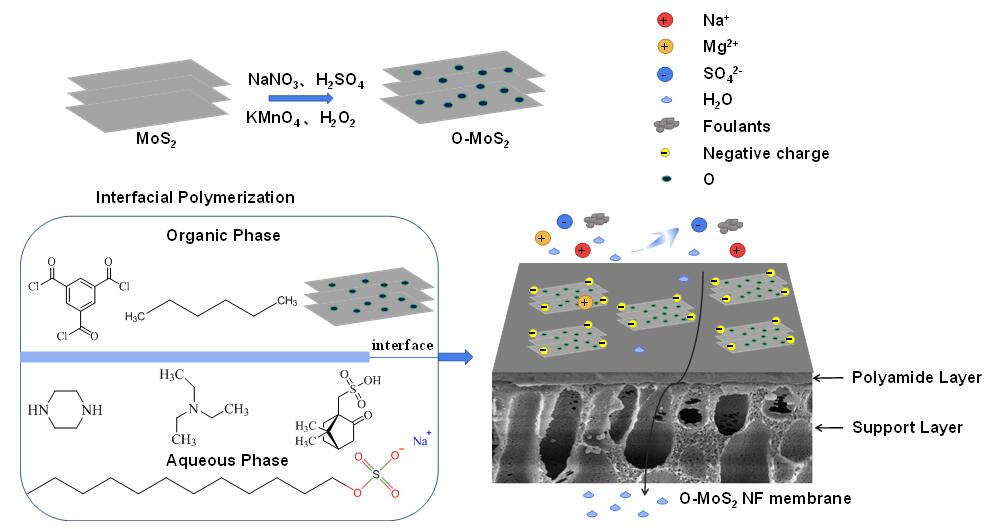Nanofiltration (NF) membrane has been recognized because of its advantages of low operating pressure and inexpensive equipment maintenance cost. However, the conventional thin film composite (TFC) membrane is limited by the “trade-off” phenomenon in the permselectivity, as well as the inevitable membrane fouling problem which causes significant reduction in flux. To decrease the energy consumption, preparing membranes with higher water flux, superior salt rejection and excellent fouling resistance are critically desired. Recently, two-dimensional (2D) nanosheets were found promising in membrane fabrication due to the atomic thickness, unique physicochemical properties as well as their ease of preparation. This provides new thinking and guidance for the industrial preparation of NF with excellent separation performance.
Based on this, the Membrane Science and Technology Research Group (Kaisong Zhang Research Team) of the Institute of Urban Environment, Chinese Academy of Sciences synthesized a 2D molybdenum disulfide (MoS2) nanosheets material by a facile solvent-assisted ultrasonic exfoliation method. The number of MoS2 nanosheets after exfoliation was about 5 layers, and the electronegativity and hydrophilicity were enhanced. A novel nanocomposite NF membrane was fabricated through interfacial polymerization by addition of the as-prepared MoS2 nanosheets into the organic phase at different concentrations. The characterization of field-emission scanning electron microscope and transmission electron microscope confirmed that MoS2 nanosheets were successfully embedded in the membranes. As a result, the hydrophilicity and electronegativity of the membranes were significantly enhanced. The membrane achieved its best performance at a MoS2 concentration of 0.010 wt/v% with about 2.3 times increment in water permeability without sacrificing salt rejection compared to the control membrane. In addition, oxidized molybdenum disulfide (O-MoS2) with high hydrophilicity and electronegativity was prepared by exfoliation and oxidation through Hummers’ method. The Mo-O bond and S=O bond detected by X-ray photoelectron spectroscopy and Fourier transform infrared spectroscopy confirmed the successful synthesis of O-MoS2. The nanocomposite membrane was successfully prepared through interfacial polymerization with the incorporation of O-MoS2 into organic phase. The hydrophilicity and electronegativity of the nanocomposite membranes were improved. Compared with the pristine membrane, the performance of the membrane was best when the concentration of O-MoS2 was 0.010 wt/v%. Consequently, the Na2SO4 rejection increased to 97.9%, and the water flux was 2.5 times higher. In addition, the membrane displayed excellent antifouling properties and higher stability over a long-term test. The O-MoS2 as a new generation of functional materials is expected to be effectively applied in water treatment and other fields in the future.
Two papers were published in the Journal of Membrane Science with master student YANG Shishi as the first author and ZHANG Kaisong as the corresponding author, “Few-layers MoS2 nanosheets modified thin film composite nanofiltration membranes with improved separation performance. 2020,(595)117526” and “Few-layers 2D O-MoS2 TFN nanofiltration membranes for future desalination. 2020,(604)118052”. These works were supported by grants from the Bureau of Frontier Sciences and Education (QYZDB-SSW-DQC044) and the Bureau of International Cooperation, the Chinese Academy of Sciences and the Joint Project between CAS-CSIRO (132C35KYSB20170051).

Diagram of interfacial polymerization.